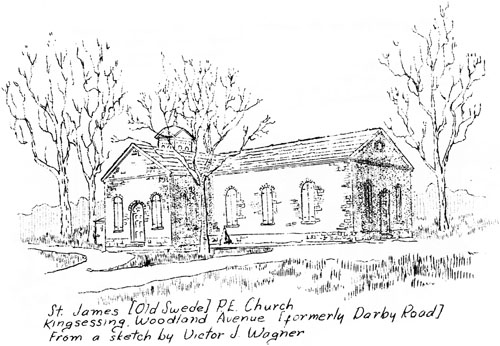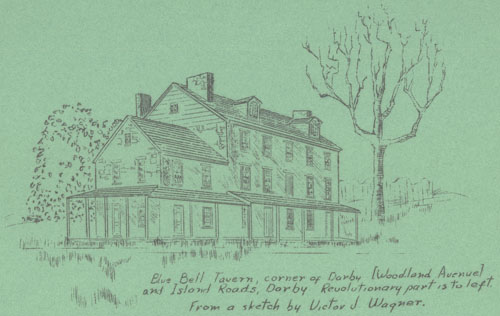|
Home : Quarterly Archives : Volume 2 |
Tredyffrin Easttown Historical Society |
|
Source: July 1939 Volume 2 Number 3, Pages 75–81 New light on the encampment of the Continental Army at Valley Forge: Part VI. The last ten days Editor's Note: The spelling of "Sterling" in several places in this article should probably be "Stirling" - the correct spelling for General "Lord" Stirling. Dr. Fitzpatrick of the Congressional Library has recently raised the question of where the Continental Army was posted during the last ten days of its occupation of the Trans-Schuylkill region. He quotes from a letter of General Washington to his most trusted and beloved companion-in-arms, General Nathaniel Greene, under the date of June 8, 1778, to the effect that the army was to march on the tenth at 8 o'clock, A. M., from its encampment at Valley Forge to a little distance removed. This location is described as convenient to the accommodation of the men, well provided with wood and water and at such distance from their former position that they should run no risk of it being gained by the enemy on a sudden attempt before the army could repossess it and make their dispositions. Dr. Myers contributes a corrobatory note in an extract from the journal of Henry Dearborn: "June 10, 1778. The whole army moved out of Huts into tents to Day, about one mile in front of our old encampment for the sake of fresh air." The inference offered that the new position was westward is erroneous. Woodman, though sometimes faulty and disingenuous, has nevertheless written much authentic and original matter. He may be quoted here: "A line of outposts commenced at the river Schuylkill opposite Mattson's Ford (opposite Conshohocken) extending in a southwesterly direction several miles, that portion of the country lying on the prescribed lines of the army. The command of these was given to General Sterling who was encamped near the Schuylkill on the Gulph hills and, from this circumstance the place was known as Rebel Hill, a name it still retains. The General while here was quartered at the home of John Reese." Woodman does not give the date of the change of base of Sterling, or of DeKalb who also quartered at the Reese house, but it is evident from his further remarks that it was near the opening of the active campaign of 1778. At all events the Major General of a Wing or a Division would scarcely be assigned to a mere outpost. The following is from Washington's Orderly Book: "June 7, 1778. The General Court Martial where Colonel Chambers is President is dissolved and another ordered to sit--Lieutenant Colonel Livington (sic) will preside, to sit at Gulph Mill." "June 9. The Army is to take a new camp tomorrow morning at 8 o'clock. The whole to be in readiness accordingly and to march to the respective grounds of encampment, which will be pointed out to each Division by Q. M. general." "June 11. All waste of timber is to be avoided. The Commanding Officer will know that their Q'r Masters attend particularly to this business." In a published letter written by the Hessian Major Baurmeister, the following appears: "On the night the seventeenth and eighteenth June, General Clinton moved into the lines, which caused Washington to believe that we would attack him at Valley Forge after all. Since the fourteenth he has been posted with 7,000 men in a clearing three English miles in front of his camp with his right wing covering the Lancaster Road and his left wing close to the Gulph Mill. General Mifflin with 600 men occupied an outpost at Sorrel Horse, seven English miles from our bridge across the Schuylkill." Washington's assurance that the fortified hills at Valley Forge could be easily regained bofore the enemy, Dearborn's statement that the new position was in front of the eld, Woodman's notes on Rebel hill, the General Court Martial removal to the Gulph Mill, the Commander-in-Chief's orders and the Hessian officer's belated intelligence, all point to a forward movement and a new encampment. This position appears to have been held for upward of ten days to exercise the army and in anticipation of either an attack or evacuation of the enemy. It was the logical move of a regenerated army to first defend the ford and bridge and then,if forced, to regain the almost impregnable hills of Valley Forge. The new position is thought to have been on the Radnor Hills or possibly as far advanced as Bryn Mawr, with the right flank covered by Morgan's riflemen somewhat advanced from the Sorrel Horse Tavern, and the left flank by Sterling on Rebel Hill which commanded Mattson's Ford. Washington certainly did not expect an attack or he would have ordered up Smallwood's brigades from Wilmington to cover his right wing. Washington's ambiguous general orders successfully prevented advance intelligence of the direction of his movements, and the enemy, agreeable to orders from home, shamelessly moved out on June 18 without striking a blow. It was here, not at Valley Forge, that Washington received the intelligence of the evacuation from the ill-fated Quaker-Tory, John Roberts. Washington immediately dispatched Maxwell with the New Jersey brigade across the Delaware to harass the enemy on their march, while he led, June 19-21, his well disciplined army, by division, over Sullivan's Bridge in the following order: 1st. Major General Lee, with the brigades of Poor, Varnum, and Huntington, en route to New Jersey via Coryell's Ferry. 2d. Major General Mifflin, with the three Pennsylvania brigades, to cross at Sherid (sic). 3d. Major General Lafayette, with the brigades of Woodford, Scott, and North Carolina, via Coryell's Ferry. 4th. Major General DeKalb, with the brigades of Glover, Patterson, and Learned, via Easton. 5th. Major General Sterling, with the brigades of Weedon, Muhlenberg, First and Second Maryland, via Coryell's Ferry. It is needless to state that the enemy was overtaken at Monmouth where the Americans gained a well earned victory. Clinton in his flight lost more than 2,000 men in killed, wounded, captured, and by desertion. After the devoted patriotic army moved to other scenes of trial, night settled upon the abandoned camp grounds, of all prospects the most desolate, and here doubly so, since it was filled with the most poignant memories, if not with the spirits of the dead. The old deserted parade grounds became a terror to the superstitious. Few of the country people could be induced to cross it after dark and many were the stories told, with lowered voices, of the shades of the gibbeted spies seen walking abroad. The home folks, however, no longer startled at the rattle of accouterments, the sharp challenge of the sentry or the report of gunfire, and heaved sighs of relief, for the occupation had been burdensome in the extreme. For a time at least, in contemplation of their ruined farms and finances, relief gave way to a feeling of despair, until they discovered the cure in labor, early and late, for work brings its own reward, and though the war continued for several more years, the invader never again set foot upon Pennsylvania soil.
Harriton House, residence of Charles Thomson, Old Gulph and Roberts Roads, from a sketch by Victor J. Wagner of an old print 1877
St. James (Old Swede) P.E. Church, Kingsessing Woodland Avenue (formerly Darby Road) from a sketch by Victor J. Wagner
"Lighthorse Harry" Lee's quarter at Signal Hill; intersection of Newtown and Sugartown Roads, front view, from a sketch by Victor J. Wagner
"Lighthorse Harry" Lee's quarter at Signal Hill; intersection of Newton and Sugartown Roads, rear view, from a sketch by Victor J. Wagner
Blue Ball Tavern, corner of Darby (Woodland Avenue) and Island Roads, Darby; Revolutionary part is to left, from a sketch by Victor J. Wagner |




